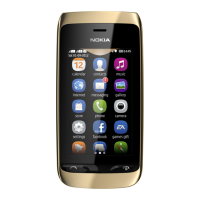
Do you have a question about the Nokia 308 and is the answer not in the manual?
| Network | GSM |
|---|---|
| GPRS | Yes |
| EDGE | Yes |
| Announced | 2012, September |
| Status | Discontinued |
| Type | TFT capacitive touchscreen, 65K colors |
| Alert types | Vibration, MP3 ringtones |
| Loudspeaker | Yes |
| 3.5mm jack | Yes |
| Card slot | microSD, up to 32 GB |
| Phonebook | Yes |
| Call records | Yes |
| Primary | 2 MP |
| Video | Yes |
| WLAN | No |
| USB | microUSB 2.0 |
| Messaging | SMS, MMS, Email, IM |
| Browser | WAP 2.0/xHTML, HTML |
| Games | Yes |
| Java | Yes, MIDP 2.1 |
| Stand-by | Up to 510 h |
| Talk time | Up to 6 h |
| 2G bands | GSM 850 / 900 / 1800 / 1900 |
| Weight | 104 g |
| SIM | Dual SIM (Mini-SIM) |
| Size | 3.0 inches |
| Resolution | 240 x 400 pixels |
| Internal | 20 MB |
| Bluetooth | v3.0, A2DP |
| Radio | Stereo FM radio |
| Battery | Li-Ion 1110 mAh battery (BL-4U) |
| Colors | Black, Red |
Identifies and explains the physical components and buttons of the phone.
Step-by-step guide on how to insert the SIM card and battery.
Instructions for charging the battery and turning on the phone.
Configuring which SIM card is used for calls, data, and messages.
Locking keys, changing volume, and attaching a strap.
General guidance on interacting with the phone's interface and screens.
Organizing the main menu and changing wallpaper.
Adjusting phone profiles and setting custom ringtones.
Using the phone in flight mode and interpreting status icons.
Explains how to use the phone's built-in calculator application.
Initiating, receiving, forwarding, and barring calls.
Adding, editing, saving, and copying phone contacts.
Using on-screen keypads, keyboards, and predictive text.
Sending messages, handling attachments, and checking voicemail.
Setting up and sending email accounts.
Setting alarms and managing calendar entries.
Taking photos, recording videos, editing, and sharing media.
Playing music, using the radio, and recording sound clips.
Accessing websites and browsing the internet.
Pairing Bluetooth headsets and connecting to computers.
Using maps for location, searching, and route planning.
Securing the phone and memory card with passwords.
Erasing all data from the memory card.
Steps to secure data before disposing of the phone.
Resolving common issues and updating phone software.
Explanation of PIN, PUK, IMEI, and Lock codes.
General safety guidelines, restricted areas, and hearing protection.